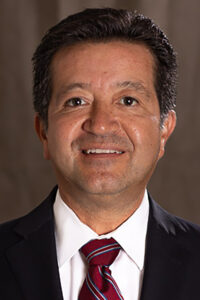
Vice President, Buy to Pay, Sourcing, Kaiser Permanente
The Journal of Healthcare Contracting: What’s the most challenging or rewarding project you have worked on in the last 12 to 18 months?
Carlos Aguilar: I would have to say the most challenging for us has been reconfiguring our supply chain and identifying new sources to meet our PPE needs. Everything from gowns, masks, and gloves to needles, syringes, and sanitary wipes were in shortage. It has been quite a range of categories and products that we had to identify new sources for, making sure that products and suppliers were verified and vetted. That was a big challenge, largely because there was a global shortage of all these products. But we also ran into more disruptions. Right when we solved one category, another arose. For example, once we had a handle on the PPE supplies, then it was a shortage of the ultra-low temperature freezers for the vaccines, needles and syringes.
I would say the most rewarding project was when we had the supply chain stabilized and got to the point where we were setting up mass vaccination sites. This is really where the rubber meets the road. We set up large venues where we can help high volumes of our members get vaccinated, as well as the community at large. That is when it finally felt like there was light at the end of the tunnel, not just for our organization and our members but for all of us. Seeing all that come to fruition, that made it feel like we were not just treading water, but we were making the major progress we needed to overcome the pandemic.
JHC: What changes brought on by the pandemic are here to stay regarding the supply chain?
Aguilar: The biggest challenge that we all recognize throughout the industry is there has been a lot of leaning out of our traditional supply chains in health care due to inventory issues and limited availability. When something like the pandemic hit, there just wasn’t enough buffer in the inventory. As a nation, we’ve been looking at some of those regulatory changes that have been passed at the local and national levels. But I think making sure that we are considering inventory and redundancy of supply, geographic diversity (domestic and global sources), and supply assurance is going to stay with us. And we’re asking the question more broadly than just PPE. We’ve always looked at that in other categories, like pharmaceuticals and elsewhere, but now with the pandemic, I think we’re revisiting and looking at that much more broadly than just PPE. What categories? What inventory? What risk mitigation plans do we need to put in place?
I’d say the second one that certainly was an eye opener for us is, as we worked with our manufacturers and distributors, it became pretty clear to us that suppliers and distributors didn’t always have complete control of the supply chain down to raw material at the factory level. That’s another area I think we’re taking away as an insight and one where we’re putting in more controls, more rigor, more due diligence around really understanding all aspects. What factories? What are they doing to assure supply assurance at the factory level? How are they going about verifying the quality of those products? It’s really taking that extra level view into the first, second and third tier in the supply chain.
JHC: In order to maintain supply chain continuity, have you added or changed anything as far as storage, warehousing, or self-distribution?
Aguilar: We’ve done a combination of things. Prior to COVID, we had implemented a hybrid pharmaceutical distribution strategy through partnerships with a national pharmaceutical national wholesaler and third-party logistics leader (3PL). The 3PL direct channel stored, inventoried and distributed pharmaceuticals that showed a benefit to KP of a cost savings or supply assurance for care critical items.
As the pandemic hit, we had to expand these areas. We worked closely with our supply chain 3PL partner, who manages those warehouses and we’ve had to expand our relationship with them to cover some of the PPE categories as well. But I think as we look ahead, it’s probably going to be part of our ongoing strategy. We just need to figure out how to optimize it. It really comes down to understanding the potential risk for which categories and what inventory levels might be affected. We want to make sure that we’re not just solving for this pandemic but anticipating any future disruptions too.
JHC: What project or initiative are you most looking forward to?
Aguilar: We’re looking at our end-to-end digital supply chain and transforming it. That was one of our major priorities before COVID hit. Obviously, when COVID hit, we needed to shift our priorities. But we’re at that point where we’re stable enough and mobilized, and we just launched that blueprint phase for the digital transformation.
That is probably the most exciting because after a year plus being in triage mode, it’s nice to be back into a project where you’re transforming and improving your operation. It covers the entire span of our organization from sourcing, ordering distribution, supply chain all the way through payables. We’re very excited about getting that moving again.
